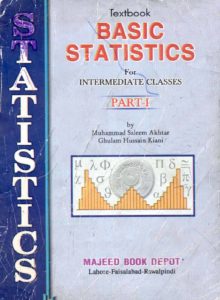
Free download the book Basic Statistics Part 1 is for intermediate classes. This book is published by Majeed Book Depot and the author of the book is Muhammad Saleem Akhtar.
Features of this book include solved examples, simplified language, diagrams for effective illustration, short definitions, multiple-choice questions and short questions.
We start with a straightforward illustration. There are a large number of traveler autos in the Unified States. What is their normal esteem?
It is clearly unrealistic to endeavor to tackle this issue specifically by surveying the estimation of each and every auto in the nation, including each one of those numbers, and after that separating by however numerous numbers there are.
Rather, all the better we can do is appraise the normal. One regular approach to do as such is haphazardly select a portion of the autos, say 200 of them, learn the estimation of every one of those autos, and locate the normal of those 200 numbers.
The arrangement of every one of those a large number of vehicles is known as the number of inhabitants in intrigue, and the number appended to everyone, its esteem, is an estimation. The normal esteem is a parameter: a number that depicts a normal for the populace, for this situation money related worth.
The arrangement of 200 autos chose from the populace is known as an example, and the 200 numbers, the financial estimations of the autos we chose, are the example information.
The normal of the information is known as a statistic: a number ascertained from the example information. This case represents the significance of the accompanying definitions.
Proceeding with our case, if the normal estimation of the autos in our example was $8,357, at that point it appears to be sensible to reason that the normal estimation of all autos is about $8,357.
In thinking along these lines we have drawn a deduction about the populace in light of data got from the example. As a rule, statistics is an investigation of information: depicting properties of the information, which is called distinct statistics, and making inferences about a populace of enthusiasm from data separated from an example, which is called inferential statistics.
Processing the single number $8,357 to abridge the information was an activity of spellbinding statistics; utilizing it to create an impression about the populace was a task of inferential statistics.
The estimation made on every component of an example requires not to be numerical. On account of vehicles, what is noted about every auto could be its shading, its make, its body write, etc.
Such information is all out or subjective, instead of numerical or quantitative information, for example, esteem or age. This is a general qualification.

Need keey book for this book
I need introduction to statistics by Afzal Beg
I need basic stastics solution book part 1 by hula khiani or professor saleem akhter
Its urgent Admin Please If you have the book send it to me
i need statistics for fg college BY Dr. M Afzal Beg & Miraj Din Mirza of Caravana Book House
Salam this book is not downloading
Free Download FSc Notes and Past Papers
good
nice
kindly share me also statistics for FA part 1
https://freebooks.pk/download/1st-year-basic-statistics-book/
thanks for the sharing http://pakjobsalert.com/
I want statistics practical 1st year peshswar board
need stats. saleem akhtar solution. urjent
I want ist year statistics solved exercise.
I also need basic statistics part 2 by ghulam hussain kiyani
A very good effort. Allah Bless you dear
I need basic statistics part 2 by ghulam hussain kiyani
Jazak’ALLAH
i want a solution book
basic statistics part 2 by ghulam hussain kiyani
Me also do u have ?
I need basic statistics part 2 by ghulam hussain kiyani